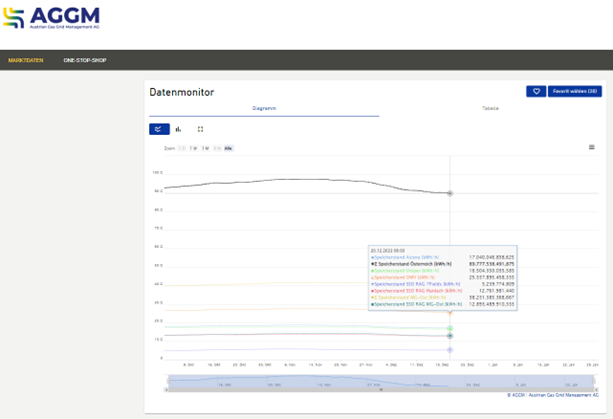| View in browser |
|

|
||
|
|
|
| Important News |
|
Important news
Calorific value tracking in grid levels 2 and 3 |
|
Good to know
AGGM platform users: Call for data cleansing Cross-sector energy crisis exercise |
|
AGGM in dialogue
________________________________________________________ |
|
Dear readers, In our last newsletter of 2023, we want to look back on the past year and, of course, never forget to look ahead. We would like to start with the current supply situation and an outlook for this winter. Austria's gas storage facilities are currently filled to 89.8 TWh, which corresponds to Austria's average annual gas demand. Gas from Russia is still flowing at the agreed volumes. We can therefore be optimistic about supplies for the current winter. Unfortunately, key financing issues have not yet been resolved for the projects to increase import capacity from Germany, which must be implemented quickly in order to increase security of supply in Austria. The current logic of infrastructure expansion, whereby additional capacity is created by the grid operators on the basis of specific market demand, does not work for strategically important security of supply investments. Solutions must finally be found here together with regulation and politics. The diversification of supply routes from Germany and Italy is also being made increasingly difficult by the introduction or increase of gas storage levies in the two neighboring countries, which we believe are in breach of EU law. More on this in the following article. This and the need to decarbonize the energy system have prompted us to draw up an H2 roadmap for Austria. We published this at the beginning of the year as part of the Austrian Gas Infrastructure Day (AGID), thereby highlighting a possible path into the energy future. The H2 roadmap is made up of the demand survey for renewable gases (methane AND hydrogen) and the hydraulic calculations of our experts, which existing pipelines can also be used for the transportation of pure hydrogen and where new construction would be necessary. When creating the roadmap, care was taken to ensure that a comprehensive methane network is available for all end users at all times and that a hydrogen network is created in parallel. We have presented this roadmap several times, including to the relevant ministries and authorities, and have met with great interest. The regulatory authority E-Control has also approved and authorized the first hydrogen infrastructure projects in the infrastructure plans as "planning projects". The H2 roadmap can also be found in the Austrian Integrated Network Infrastructure Plan (ÖNIP) of the Federal Ministry for Climate Action, Environment, Energy, Mobility, Innovation & Technology (BMK). From world champion of targets to implementation champion - that must be the motto for 2024! Unfortunately, however, the regulatory environment has not provided the clarification we had hoped for regarding the planning and construction of hydrogen pipelines. The topic has been discussed many times at a political level, but it has not yet led to the necessary legislative changes or the creation of a suitable regulatory framework. Nevertheless, we are trying to remain optimistic for the new year and hope for courageous decisions, even if the productive phase before the upcoming election campaigns (EU and National Council elections) will probably only be short. We are also optimistic that our inGRID, our digital feed-in card for renewable gases, has been so well received and has even made it into specialist articles and newsletters from various companies. We are also very satisfied with the result and can be quite proud of our inGRID. For those who don't yet know, inGRID offers all interested parties a quick way to find suitable feed-in points for biomethane and, in future, hydrogen. On the other hand, our tool also provides information on suitable locations for the construction of biogas plants, as the regionally available green gas potential is stored. You can also try it here. To remain optimistic, we can already get you in the mood for the new year. Austria and Europe have embarked on the path to decarbonization. We will continue to pursue this goal at full speed. We will update our H2 roadmap in 2024. It will then also be given a new name, as it not only covers the capacity and volume requirements for hydrogen, but also for biomethane (from solid and wet biomass residues) and maps the respective pipeline network required for this. Another aspect that will concern us is carbon management, i.e. the capture, transportation and storage of CO2. These technologies will also have to play a role in the complete decarbonization of industry and energy. Our task is to evaluate the technical and regulatory options for establishing a CO2 network and to develop corresponding proposals. "The energy transition in the pipeline" continues to be not only our motto but also our mission. With this in mind, we wish you a Merry Christmas and a relaxing holiday season. Our most important wish for you: stay healthy and optimistic! Your AGGM ____________________________________________________________________ |
|
Important news
In addition, the Italian regulatory authority ARERA recently published a consultation document proposing to levy a "neutrality charge" of €2.1908/MWh on gas withdrawals from the Italian transmission system and thus also on exports from Italy from 1 April 2024. Source: ARERA
|
|
Calorific Value Reconstruction in Grid Levels 2 and 3
With the integration of renewable gases, the decentralized feed-in of biomethane and hydrogen and thus different gas qualities into the gas grid will increase. With inGRID - the interactive feed-in map for renewable gases - we have made it transparent where biomethane can be fed into the gas grid most efficiently. With the increasingly decentralized feed-in of renewable gases, it is also becoming more and more important to be able to track exactly how high the calorific value of the transported gas is at certain transfer and withdrawal points....
|
Good to know

|
|
AGGM platform users: Call for data cleansing
We therefore ask all active market participants to regularly check the relevant information and master data in the AGGM platform and keep it up to date. Where can you do this? In your AGGM account you can
|
|
API interface to the balance group status
To retrieve this data automatically, BGV users can apply for a token in the AGGM account on the AGGM platform. For the exact procedure, open the guide. The data is updated hourly. |
|
Cross-sector energy crisis exercise
The primary goal of the exercise was to simulate a realistic energy crisis scenario. The scenario involved a combination of factors such as extreme weather conditions, interruption of gas imports, pipeline breakage and a solidarity request by a neighboring country. Key highlights The exercise facilitated active participation from representatives across the energy sector (natural gas and electricity). The efforts by the participants from energy companies, BMK and the regulatory authority E-Control demonstrated the importance of effective communication and coordination in managing a crisis. Further, participants tested the efficiency of existing regulations and instruments, among others the use of the Merit Order List including real-time bids and monitoring. The exercise also emphasized the role of public awareness and engagement in times of crisis and focused on public communication via social media platforms. In conclusion, the cross-sector energy crisis exercise was a valuable opportunity to test the industry’s preparedness for potential critical situations and strengthen the collaboration among participants. Insights gained will contribute to refining and adapting established procedures to better address potential future shortages of supply. |
AGGM in dialogue
Gas is an important part of the German energy system and will remain so in the future. In future, our energy supply must be climate-neutral - at the same time, we also need a resilient system, as the past two years in particular have shown us. The solution is an energy system based on two pillars: green electricity and green molecules. This also means that the gas industry will change. The use of fossil, non-decarbonized natural gas will become irrelevant by 2045. Instead, we will use new gases such as hydrogen and its derivatives as well as biomethane....
|
|

